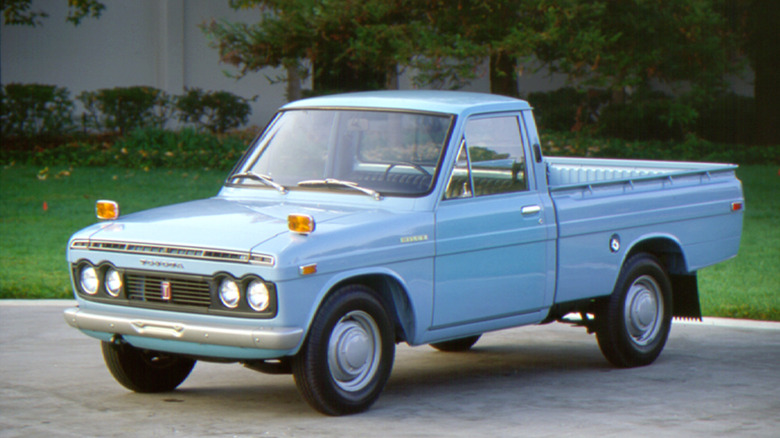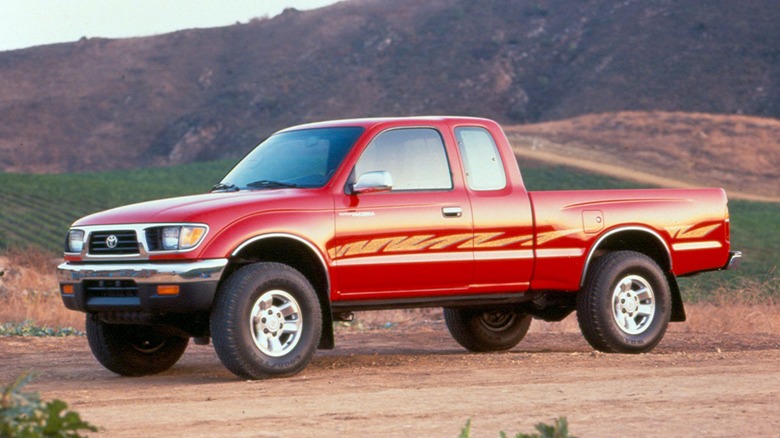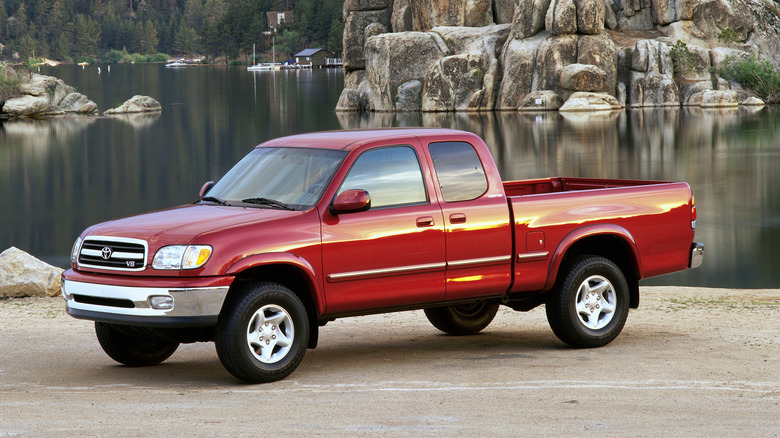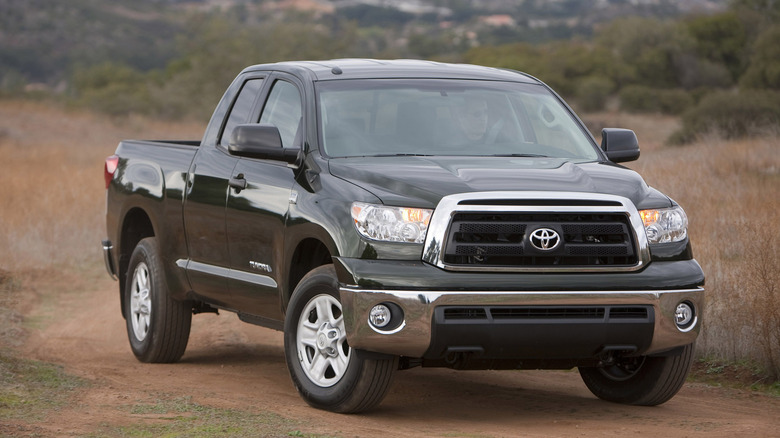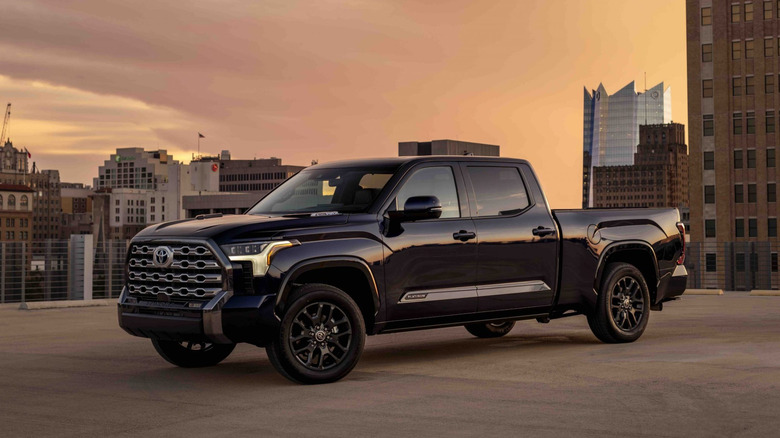The History Of Toyota's Iconic Pickup Trucks In The U.S.
Look at the pickup truck sales figures in the U.S., and you'll see American manufacturers dominating the charts. Foreign automakers might've won the passenger car market, but they couldn't crack the code in the pickup truck category. Except, of course, Toyota. The all-conquering Japanese automaker not only mastered the trick with its trucks, but it outclassed its American competition in the mid-size category with the Tacoma. The Tundra is selling well, too.
You might not be surprised to learn that Toyota's truck voyage wasn't all sunshine and rainbows, but with each generation, its models resonated with a growing pool of customers. But how did Toyota become a force to be reckoned with in the pickup truck sector? Was it always the Tundra and Tacoma carrying the load? These are the things you'll be learning in today's automotive history lesson, where we'll cover every Toyota pickup truck that reached U.S. dealerships.
1961 Toyota FJ45 Pickup — Toyota's first pickup truck in North America
Toyota's first pickup truck, the G1, paved the way for what is today the world's largest automaker back in 1935. However, it took Toyota almost three decades to penetrate the U.S. market. Two models were available at launch — the Crown and FJ45 Land Cruiser pickup truck. They weren't very successful, and that was especially true for the truck, which lived for only one year.
However, success in other markets made the FJ45 an icon; the antique truck is still sought after today as a restomod. Oh, and it was the vehicle that built Toyota's reputation for unmatched reliability and catapulted the Land Cruiser name into prominence. The FJ45 was kind of great at off-roading, too. Four-wheel drive. Two-speed transfer case. Ladder chassis with front/rear live axles. It might be old, but the FJ45 will smoke modern crossovers on any challenging terrain.
Under the beautifully sculpted front bonnet, the FJ45 hides an F-Series, 3.9-liter inline-six with 128 hp. Not much, even by the standards of its day, but this was never a truck made for racing. It was unstoppable, though, with owners getting 500,000 miles from this engine quite regularly. But this only makes us sadder that the FJ45 Land Cruiser pickup never caught up in the U.S.
1964-1969 Toyota Stout — Where it all (really) started
After watching the U.S. market for a few years, Toyota was ready for its all-out offensive. So, in 1964 it brought out the Stout pickup truck, which was already on sale in Japan for four years. Way more compact than the FJ45, the Stout was marketed as a mid-size, half-ton truck during the 1960s. Today, though, at 184.65 inches (4,690 mm) long, the Stout is comfortably smaller than a Camry.
The small footprint gives it a more casual vibe, though it was still a capable truck that was designed to get things done. Toyota was all-in with the design, incorporating modern elements for the era, like a flat-top hood and funky-looking twin-circular headlights. The bed is also nicely implemented onto the truck, following the body lines and surfaces perfectly.
Under the flat-top bonnet, Toyota fit a 1.9-liter four-cylinder engine producing 86 hp. It was unfortunately only available with a 4x2 drivetrain, unlike its predecessor. Predictably, sales never took off, and the Stout quickly faded into obscurity. Curiously, though, the nameplate stood the test of time and became popular among Toyota aficionados. Perhaps it's the design or the compact footprint, but the Stout proved to be influential. Consequently, Toyota might bring back the Stout pickup truck soon to compete with the Hyundai Santa Cruz and Ford Maverick.
1968-1978 1st & 2nd Gen Toyota Pickup — Bringing the Hilux to the States
The Toyota Hilux is the best-selling pickup truck not sold in the U.S. Famous for its reliability and toughness, the Hilux dates back to 1968 when the first model was launched globally. Powered by a meager 1.5-liter engine that produced only 76 hp, the first Hilux was aimed directly at buyers who wanted a vehicle that got the job done.
A year later, the Hilux arrived in the U.S. American buyers were honored with a larger 1.9-liter four-cylinder producing 84 hp, upgraded to 97 hp after Toyota implemented SOHC. A year after launch, though, the Hilux was available with the 2.0-liter 18R engine, which produced 109 hp. Not much, but it made the truck a better daily driver.
For whatever reason, though, the automaker decided to forgo the Hilux name in North America for the second-gen model, and simply called it the Toyota Pickup. Honestly, it might have suited the vehicle better as there was really nothing Highly Luxurious about the pickup truck anyway — it was just basic transportation of people and goods.
Even so, Toyota made significant changes, like offering a long-wheelbase version in North America. The 2.0-liter 18R engine remained as an option, though in 1975 it was replaced with the 2.2-liter 20R engine. Due to tighter emission regulations, the 20R made only 97 hp, although it was also more reliable and easier to maintain, which became a theme with Toyota trucks going forward.
1978-1994 3rd to 6th Gen Toyota Pickup — Building a Reputation for Unmatched Reliability
The Toyota Pickup was already popular as a cheap, barebones truck with solid reliability. However, starting with the third-gen model, launched in 1978 in the U.S., Toyota's truck started establishing itself as one of the most reliable vehicles on the planet. A big part of that was the new 2.4-liter 22R four-cylinder, which gained a reputation for being almost unbreakable. The fuel-injected 22RE version provided good fuel economy, too, and later there was a turbocharged 22R-TE version that offered 137 hp.
However, the truck was also designed with durability in mind. With its strong ladder chassis and tough mechanics, the Toyota Pickup could rack up thousands of miles with ease, even on challenging off-road terrains. Top Gear even famously tried to kill a fourth-gen Toyota Hilux, unsuccessfully. They even put it over a building that was demolished using dynamites, and it still worked. If you wondered, yes, it's the same model as the North American pickup.
Still, by the time the sixth-gen model arrived in 1989, buyers wanted a bit more comfort. So, Toyota responded by implementing a new 3.0-liter V6 engine, good for 150 hp. Moreover, the truck featured a front-independent double wishbone suspension with a torsion bar to improve ride comfort and on-road dynamics. The pickup looked smoother, too, adding to its appeal. However, Toyota's no-name approach with its mid-size truck wouldn't have worked for long, with sales slowly declining toward the end of the model's lifespan.
1992-1998 Toyota T100 — Fighting the full-size battle
The Toyota Pickup kept the automaker competitive in the smaller truck market, but to truly attract buyers, the company needed an entry into the lucrative full-size category. So, in 1992, it launched the T100 — its first-ever full-size truck. It was a pioneering effort for Toyota, as the T100 was also the first import in the category. Still, Toyota's entry was smaller than its American full-size rivals, by design. The automaker did its homework before launching the T100 and found that many buyers wanted the capability of a full-size truck, but the maneuverability of a mid-size truck.
That's all fine, but the T100 also lacked a V8 offering. Toyota might've spent six years on marketing research, but its employees were probably pretending to be deaf when people mentioned V8s. That, or Toyota simply didn't have one ready. Still, the lack of a V8 led to abysmal sales, which peaked at around 38,000 in 1996. To put it into context, Ford sold around 800,000 F-150s in 1996!
Heck, Toyota even offered a 2.7-liter four-cylinder, imagine what the American buyer would've thought of that! Fortunately, Toyota also offered two V6 engines — a 3.0-liter and a 3.4-liter. The former produced 150 hp, while the latter made 190 hp. Again, it was far from impressive, forcing Toyota to kill the model after six years.
1994-2004 1st Gen Toyota Tacoma — The birth of a legend
After seeing declining sales of its mid-size pickup truck, Toyota went to the drawing board to create an all-new model. The big move was cutting all ties to the Hilux, which remained as an international model. Enter the Tacoma — Toyota's first-ever mid-size truck designed specifically for American and Canadian buyers. Not only that but the Tacoma was even made in the USA.
The Tacoma was also more comfortable. Better-looking. You could argue that it lost some of the ruggedness of the Toyota Pickup. Still, the auto market became different during the 1990s, with people buying trucks for themselves, not just for work. Still, the Taco didn't throw away all ties to the Pickup. You could still have it with a 4x4 drivetrain, including a mechanical transfer case for better off-road traction.
The engines were pulled from the T100, which worked better in a mid-size truck. Two four-cylinder options were available — the entry-level model had a 2.4-liter unit and was offered exclusively with 2WD. A larger 2.7-liter unit was available with 4x4 and an off-road-focused trim, the Prerunner. At the top of the range was the 3.4-liter V6 with 190 hp, an excellent figure for the era. From the start, the Taco was also available in three body styles — regular, Xtracab, and double cab. Unsurprisingly, all these upgrades resonated with buyers, and the Tacoma quickly became a staple in the mid-size category.
1999-2006 1st Gen Toyota Tundra — Full-size rebirth
After fully refreshing its mid-size offering, Toyota was ready for a radical redesign of its full-size truck. Now called the Tundra, the new model shared almost nothing with the T100. Built in America, the Tundra was announced in 1998 as one of Toyota's most important models.
Crucially, though, the Tundra had a V8 under the bonnet. However, it wasn't just any V8 — the 4.7-liter unit was the first double-overhead camshaft (DOHC), 32-valve V8 engine in its category. As a result, it produced a healthy 245 hp and made the Tundra the first full-size truck to receive the L.E.V. (low-emission vehicle) classification from the EPA. By the end of its lifecycle, Toyota eventually pushed the engine to 282 hp, showcasing its potential. Today, the 2UZ-FE V8 is also famous for being one of the most reliable Toyota engines.
However, the V8 engine was only a part of the story. The Tundra was also available in regular and Access-cab configurations, two- or -four-wheel drive, three trim levels, and a V6 offering as well. Moreover, a ladder chassis with a fully boxed front section and six stiff cross-members made it the most rigid half-ton truck in the category. The result? A towing capacity of up to 7,200 pounds. Meanwhile, the interior was well-appointed, sprinkled with Toyota's stellar build quality. Somewhat unsurprisingly, MotorTrend named the Tundra its truck of the year for 2000.
2005-2015 2nd Gen Toyota Tacoma — Focus on off-road and reliability
The Tacoma already had a reputation for reliability and off-road capability, but with the second-gen model, Toyota doubled down on those qualities. The TRD Off-Road package was better equipped in the new model, too. Locking rear differential. Bilstein monotube shocks. Hill assist feature. All-terrain tires. Basically, everything you need to traverse challenging terrain. The design of the truck corresponded to the rugged image, too. A masculine front fascia and sculpted body with wider fenders led to a more attractive overall look.
Still, the biggest news was the addition of an all-new 4.0-liter V6. With 245 hp and 282 lb-ft of torque, it brought the Tacoma to 60 mph in just 7.4 seconds. Not only that, but it was also available with a six-speed manual, appealing to enthusiasts. Truckers were covered, too, with the V6 option pushing the towing capacity to 6,500 pounds. Meanwhile, budget-minded were offered a 2.7-liter four-cylinder with 164 hp.
The second-gen Tacoma was more refined, too. The stiff frame with seven cross members minimized shuddering over potholes, and Toyota has put more sound insulation to increase the passengers' comfort. The cabin also looked more modern, almost like a passenger vehicle, and was equipped with advanced tech, like satellite radio. So, like its bigger brother, the Tacoma snatched MotorTrend's truck of the year award in 2005.
2007-2021 2nd Gen Toyota Tundra — Bigger, More Capable, and Faster
The first-gen Tundra was an excellent effort for Toyota, but with the second-gen model, the company turned the knob to 11. Like the second-gen Tacoma, the new Tundra looked way more muscular, with a huge front grille that increased its road presence. It was brash, bold, and unusual for a Toyota truck. Still, Toyota wasn't done. The grille went from big to massive with each facelift. The TRD Pro models even received a hood scoop to accentuate their sporty image.
Things got even more interesting under the sheet metal. The Tundra borrowed the 4.0-liter V6 from the Tacoma, producing 236 hp, and the 4.7-liter V8 from the previous generation, producing 271 hp. However, there was also an all-new 5.7-liter V8 with 381 hp and 401 lb-ft of torque. 0-60 in 6.3 seconds. Towing capacity was up to 10,800 pounds, payload was rated at 1,900 pounds. This was by far the most serious V8 the company has ever produced. Toyota wasn't going to rest on its laurels, though, and in 2010 introduced a brand-new 4.6-liter V8 with 310 hp.
Still, the Japanese automaker also pushed the category in other areas. Thanks to its extensive safety equipment, the Tundra was the first full-size truck to receive a Top Safety Pick award by the IIHS. All these upgrades again made the Tundra highly regarded among journalists and helped Toyota solidify its presence in the full-size category. Unsurprisingly, the second iteration of this truck is also our favorite Toyota Tundra generation.
2015-2023 3rd Gen Toyota Tacoma — The Taco gains a tough image
For the third-gen Tacoma, Toyota continued with the theme of the second-gen Tundra. With its more aggressive fascia and prominent grille, the Tacoma looked as aggressive as ever. This was particularly true for the TRD Pro and TRD Off-Road variants, which had special TOYOTA lettering on the front grille, desert air intake, blacked-out hood scoop, TRD Pro aluminum front skid plate, and more.
Thankfully, it wasn't all show and no go. The TRD Pro also had advanced off-road tech features to accentuate its tough image. These included TRD-tuned FOX internal bypass shocks, a 1-inch front suspension lift, an electronically locking rear differential, crawl control, and hill start assist control. Tough, indeed. Oh, and a special TRD-tuned cat-back exhaust ensured the driver's ears were properly massaged, too.
However, the biggest upgrade in the third-gen Tacoma was the new direct-injected 3.5-liter V6. Utilizing the more efficient Atkinson cycle and the company's VVT-iW technology, the new V6 made more horsepower (278 hp vs. 236 hp), while also being more efficient (20 mpg vs. 18 mpg). Real off-road enthusiasts could even pair it with a six-speed manual transmission, adding to Tacoma's appeal. With the V6, the Tacoma could also tow up to 6,800 pounds, though the truck was now only available in Access Cab and Double Cab body styles. Still, it was enough to keep the Taco at the top of its category.
2021-Present 3rd Gen Toyota Tundra — Bye V8, Hello rapid V6
Remember when Toyota added a V8 to the Tundra to compete with the big boys? Well, in a blasphemous move, the Japanese automaker removed two cylinders from its full-size truck. Instead of the 5.7-liter, a 3.4-liter twin-turbo V6 is paired to a 10-speed auto. Still, performance didn't suffer. In fact, the new engine makes 389 hp (+8 hp) and a stupendous 479 lb-ft (+78 lb-ft) of torque.
Oh, but that's not even the fun option. There is also a hybrid that produces 437 hp and 583 lb-ft of torque. Five hundred thirty-eight! Predictably, we found that the latest Tundra Hybrid will get you moving fast quite easily, and sounds good, too. In fact, zero to 60 takes only 5.7 seconds! Unfortunately, unlike other Toyota hybrids, it's not so keen on fuel economy. The best we could manage in our review was 16 mpg. Yikes! You have to love that turbodiesel-rivaling torque to be okay with this figure.
Fortunately, the Tundra is better elsewhere. It's roomier than ever, with plenty of storage space and excellent tech inside. Toyota didn't forget truckers often wear gloves, too, as there are many big buttons inside. You can also tow a 12,000-pound trailer with the Tundra, a very competitive figure in the category. Moreover, the TRD Pro model can also satisfy your sporty off-road aspirations and seems like a better fit for the potent hybrid powertrain.
2023-Present 4th Gen Toyota Tacoma — The Taco Also Loses Two Cylinders
The Tacoma once again follows Tundra's lead. See a trend here? Just like its bigger brother, the Tacoma lost two cylinders in the latest generations, while embracing turbocharging and electrification. A new 2.4-liter turbocharged four-cylinder is now the only option in the Tundra, available in hybrid and non-hybrid form. Power ranges from 278 hp to 326 hp, but again the torque figures are more impressive; the standard model sits at a solid 317 lb-ft, but the hybrid has an astonishing 465 lb-ft of torque.
Unsurprisingly, the hybrid-four makes the latest Tacoma TRD Pro an off-road king, with 60 mph arriving in 7.1 seconds Both powertrains are paired with a brand-new eight-speed automatic, though an entry-level six-speed manual model is also available. However, the electrification didn't bring any substantial fuel economy improvements, with the hybrid being rated at 26 mpg highway and 22 mpg city. At least it can tow up to 6,500 pounds, despite having only four cylinders.
Toyota followed the latest trends inside the cabin, too. You can now option a massive 12.3-inch instrument cluster and 14.0-inch infotainment screen. Still, big climate control are still present — Toyota is one of the few companies still doing this. So, foreseeably, despite all the changes, the Tacoma continues to sell strong.



